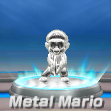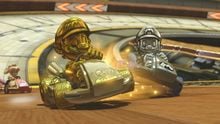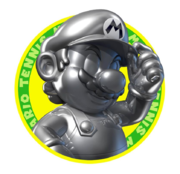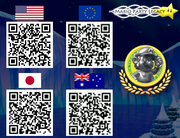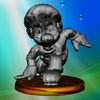- This article is about the character that resembles a metallic version of Mario. For the metal form that Mario can transform into, see Metal Mario (form). For the power-up regarding this form, see Metal Cap.
Template:Character-infobox
- “Metal Mario, the best!”
- —Metal Mario, Mario Kart 7
Metal Mario is a character in the Mario universe, usually being one of the fiercer end-game opponents in the Mario sport games or Super Smash Bros. series. He is a spin-off from Metal Mario, which is a form of Mario. Metal Mario often plays the role of Mario's rival, suggested by his role in Super Smash Bros. This is also implied in the Mario Kart games, where he says "Mia mamma" as opposed to Mario's "Mamma mia" and "Papa" instead of "Mama". Metal Mario retains many traits from the power-up variant, such as being very slow and not very agile, but being a very powerful character; many games he is playable in has the stats of larger, more powerful characters such as in Mario Kart and various Mario sports titles.
Metal Mario retains much of Mario's voice clips, voiced by Charles Martinet, and he appears voiceless in the Super Smash Bros. series, though Mario Kart 7 is the first installment where Metal Mario has his distinct set of voice clips with a filter applied over them. While Metal Mario in Mario Tennis Open and Mario Sports Superstars recycles voice clips from Mario, the aforementioned filter is still applied over those voices to distinguish him from Mario.
History
Super Smash Bros. series
Super Smash Bros.
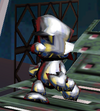
Metal Mario in
Super Smash Bros.In Super Smash Bros., Metal Mario makes his debut as a mid-boss encountered in Stage 9 out of 10 stages. He has his own stage, which is playable only in the one player mode of the game. Unlike the power-up he is based on from Super Mario 64, other characters can attack and rack up damage on him. To mirror his role in Super Mario 64, he is a far more durable character than the regular Mario; in fact he is the heaviest and most resistant character in the game. When his damage percent is low, weaker attacks cannot flinch him, and attacks start flinching him only at far higher percentages. Due to his high weight, however, he has trouble recovering when he is knocked off the stage. Additionally, Metal Mario does not dash; he mostly walks around, patrolling the stage.
On a side note, Kirby is unable to copy Metal Mario's powers, which is later possible to do in Super Smash Bros. Melee.
Super Smash Bros. Melee
Template:SSB Infobox
Metal Mario returns as a mid-boss in Super Smash Bros. Melee's Adventure Mode, being fought on Battlefield. In this game, Metal Mario fights alone by default, but if the player unlocks Luigi, Metal Luigi joins the fray as well. They both retain their strengths from Super Smash Bros.; Metal Mario and Metal Luigi are very heavy opponents who are tough to knock down the stage, but cannot recover once they are knocked down. Additionally, players can pick up the Metal Box item, turning into metal forms, boasting the same attributes as Metal Mario and Metal Luigi, though the power-up is not permanent, unlike Metal Mario and Metal Luigi. KOing Metal Mario and Metal Luigi in Adventure Mode awards the player the "Metal Bros. KO" bonus, worth 8000 points.
He also appears as one of the many collectible trophies in the game. Yoshi's Island, a stage in the game, is reflected on the texture of Metal Mario's model.
Super Smash Bros. Ultimate
In Super Smash Bros. Ultimate, Metal Mario appears as the final boss in Bowser's classic mode route, appearing after Mario is defeated in a similar manner to Giga Bowser in Mario's route and in Super Smash Bros. Melee. He also appears as an Ace-class Shield-type primary spirit with one support slot, using his Mario Kart 7 artwork. The spirit increases a fighter's weight during battle. In the spirit's battle, the player faces a metallic Mario on the Battlefield form of The Great Cave Offensive as a reference to his battle in the original Super Smash Bros.
Metal Mario's core can be combined with the cores of a Super Mushroom and a Fire Flower to summon the Gold Mario spirit.
Mario Golf series
Mario Golf (Nintendo 64)
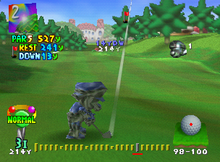
Metal Mario in
Mario GolfMetal Mario is an unlockable playable character in Mario Golf for the Nintendo 64. He is unlocked when players collect all 108 Birdie Badges. He boasts the strongest drives from his set of clubs, meaning he can hit the ball the furthest out of any character in the game, though his sweet spot and control come at a cost. Metal Mario's ball trajectory is a strong draw, meaning that the ball has a strong curve to the right. If Metal Mario scores a Nice Shot while using a power shot, the ball goes into flames, which is shared with the other Mario characters, namely Mario and Baby Mario. Metal Mario shares the exact voice clips as Mario. In Japanese versions of the game, Metal Mario is absent.
Mario Golf (Game Boy Color)
Although Metal Mario does not make an appearance in Mario Golf for the Game Boy Color, he is mentioned on the Score Card.
Dr. Mario 64 / Nintendo Puzzle Collection
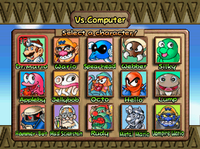
Metal Mario in the character select screen from
Dr. Mario 64Metal Mario returns as the final boss of Wario's storyline in Dr. Mario 64, where he appears as a metal version of Dr. Mario. In this game, Dr. Mario turns into Metal Mario when he accidentally eats some Megavitamins. He can be unlocked as a playable character when the Story Mode is beaten with Wario without losing once. In VS mode, Metal Mario has the highest AI level available tying with Vampire Wario.
Mario Kart series
Mario Kart 7
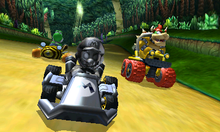
Metal Mario in
Mario Kart 7After a ten year absence from appearing as an individual character, Metal Mario makes a return as an unlockable playable character in Mario Kart 7, where he is unlocked by winning the 150cc Special Cup. He is one of four drivers to enter the Mario Kart series for the first time (the other three being Lakitu, Wiggler, and Honey Queen). He is a Heavy class character (alongside Bowser, Wario, and Honey Queen), with an advantage bonus of weight and some speed. Because he ranks among the Heavy class, Metal Mario is the fastest and heaviest character in the game, but he has the lowest acceleration and handling stats. Additionally, Metal Mario's karts have the same body frame size as that of the Medium class characters, which makes him a smaller target than the other Heavy and Cruiser characters. His signature emblem is a shiny, metal version of Mario's M logo. Bowser, Rosalina, or Mario always appear as rivals when he is picked. Additionally, Metal Mario has his own set of voice clips from Mario, and Mario Kart 7 is the first game in the Mario series where Metal Mario is given a filter to differentiate his voice from Mario's voice.
Metal Mario appears as the Normal and Expert Staff Ghosts for Neo Bowser City and DS Airship Fortress.
Mario Kart 8
- “Oh, mia mamma!”
- —Metal Mario, Mario Kart 8
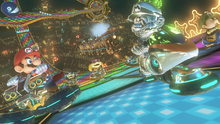
Metal Mario, in
Mario Kart 8Metal Mario appears as a returning racer in Mario Kart 8, and he is an unlockable character. Additionally, there is another character related to Metal Mario named Pink Gold Peach (who is classified in the same weight subdivision as Metal Mario). Like in Mario Kart 7, Metal Mario is classified as a Heavy character, where he has high speed and weight, but lower handling, traction, and acceleration, but within this category, he is tied with Bowser, Wario, Morton, the large Miis, and Dry Bowser in the acceleration, weight, and traction department. However, his speed and handling are tied with that of Rosalina, Donkey Kong, Waluigi, Roy, and Link.
Also much like in Mario Kart 7, Metal Mario's (as well as Pink Gold Peach's) vehicles use the same body frame size as the Medium class characters, making him a smaller and slightly harder target to hit. His kart emblem is a gray version of Mario's signature "M" symbol with a light gray outline.
Metal Mario appears as the Staff Ghost used by Nin★Leonel for N64 Rainbow Road. This combo uses the Standard ATV, Monster tires, and Super Glider.
Mario Kart Arcade GP DX
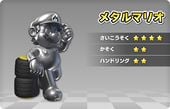
Metal Mario in
Mario Kart Arcade GP DXMetal Mario appears in Mario Kart Arcade GP DX, an arcade entry of the Mario Kart series. Just like previous Mario Kart games, he is a heavyweight, with high speed, but below average acceleration and handling. His kart is the Metal Spark. Metal Mario also has an alternate costume, Gold Mario, which not only changes Metal Mario's color scheme, but adds pupils to his eyes as well.
Mario Kart 8 Deluxe
As with every character playable in Mario Kart 8, Metal Mario returns as a playable character in Mario Kart 8 Deluxe for the Nintendo Switch, this time being available from the start. Similarly to Mario Kart Arcade GP DX, Metal Mario has a Gold Mario variant, which can be unlocked by winning every 200cc Grand Prix cup.[1] Although Metal Mario's statistics have been slightly altered when compared to the original Mario Kart 8, he is still classified in the same weight subdivision as Pink Gold Peach, and is still a heavy character.
Mario Kart Tour
Metal Mario reappears in Mario Kart Tour as a High-End driver. His special skill is the Fire Flower, shared with his normal self. Metal Mario was featured in the Beta Test alongside a self-titled cup, and was added to the release version in the New York Tour.
Metal Mario has consistently appeared in regular tour pipes, including All-Clear Pipes, and is also a part of the base Daily Selects set. Additional availabilities for Metal Mario are listed in the following table by tour. (Click "Show table" to reveal it.)
| Tour
|
Availability
|
| New York Tour
|
Gold gift
250 Grand Stars
|
| Paris Tour (2019)
|
Gold gift
200 Grand Stars
|
| Trick Tour (2020)
|
Metal Mario Pack
$19.99 / €21.99 / AU$30.99
April 22, 2020 - April 29, 2020
|
| Super Mario Kart Tour
|
Metal Mario Pack
$39.99 / €43.99 / AU$62.99
September 9, 2020 - September 23, 2020
|
| 1st Anniversary Tour
|
Token Shop
50 event tokens
|
| Mario vs. Luigi Tour
|
Team Mario
Metal Mario Pack
$19.99 / €21.99 / AU$30.99
November 25, 2020 - December 2, 2020
|
| Rosalina Tour
|
Tier Shop
12,000 coins
December 16, 2020 - December 22, 2020
|
| Peach vs. Daisy Tour
|
Token Shop
100 team tokens
|
| Mario Tour
|
Iron Cucumber Pack
$39.99 / €43.99 / AU$62.99
March 16, 2021 – March 23, 2021
|
| Bowser vs. DK Tour
|
Token Shop
100 team tokens
|
| Summer Tour
|
Premium Challenges card completion reward
|
| Mario vs. Peach Tour
|
Gold gift
100 Grand Stars
|
Mario Tennis Open
Metal Mario, in Mario Tennis Open
Metal Mario returns in Mario Tennis Open as the final QR Downloadable Character, being the only QR character that is not a Yoshi. His type in this game is Power, and, as in Mario Kart 7, his voice is a warbled variation of Mario's voice, although he has the same voice set as Mario otherwise. He is the strongest character in the game with the fastest serves, and his shots travel very quickly through the court. Due to his power and weight, he returns Chance Shots with little effect on him (if he returns them correctly), and his Chance Shots themselves have a longer-lasting effect on his opponents. He is one of the slowest characters in the game, however, and unlike Bowser, another slow character, he has below-average reach and a poor lunge, which makes it difficult for him to predict shots and reach up to them. Metal Mario's racket costs 1750 coins to buy at the Clubhouse for Miis to be able to use, where his racket can be paired with other Mario-themed costumes to get a boost in stats.
Mario Sports Superstars
Metal Mario appears as one of two unlockable playable characters in Mario Sports Superstars. In most sports, he is classified as a Power character, like in Mario Tennis Open. In golf, his default drive is 228 yards, and his shots travel very high in a draw trajectory. Metal Mario must be unlocked separately for each sport by winning the Star Cup in each sport's tournament mode or by tapping in a corresponding Metal Mario amiibo card. Most of Metal Mario's animations are identical to Mario's, with a few exceptions:
- If Mario scores a Double Bogey or worse in golf, a Green Shell hits him and he reverts to Small Mario. If Metal Mario receives one, he is buried by many Green Shells and Red Shells, although he retains his form.
- In baseball and soccer, Mario's special shots surround the ball in red fire. Metal Mario's special shots surround the ball in gray flames.
Profiles and statistics
- Main article: List of Metal Mario profiles and statistics
Super Smash Bros. series
Super Smash Bros. Melee trophy
| Name
|
Image
|
Appearance(s)
|
Description
|
| Metal Mario
|
|
Super Mario 64
9/96
|
Mario was in for a surprise the first time he hit a Metal Box in Super Mario 64. The metal cap that popped out transformed Mario into living metal, giving him great stamina, a heavy tread, and the ability to walk underwater. In Super Smash Bros., Metal Mario showed up as an incredibly stubborn midlevel boss.
|
Super Smash Bros. Ultimate spirit
| #
|
Name
|
Image
|
Series / game
|
Type
|
Class
|
Strength / effect(s)
|
How to obtain
|
Spirit battle
|
| Opponent(s)
|
Battle conditions
|
Stage
|
Song
|
| 21
|
Metal Mario
|

|
Super Mario Series
|
Primary (1)
|
Ace
|
Shield
Weight ↑
|
-Spirit Board
-Purchase from the Vault Shop for 6000G
|
Metal Mario
|
- The enemy is slow but has increased defense and attack
- The enemy is metal
|
The Great Cave Offensive (Battlefield)
|
Metal Battle
|
Game appearances
Voice clips
- Help:Media • Having trouble playing?
Gallery
- For this subject's image gallery, see Gallery:Metal Mario (character).
Names in other languages
| Language
|
Name
|
Meaning
|
| Japanese |
メタルマリオ
Metaru Mario
|
Metal Mario
|
| Chinese (simplified) |
金属马力欧
Jīnshǔ Mǎlì'ōu
|
Metal Mario
|
| Chinese (traditional) |
金屬瑪利歐
Jīnshǔ Mǎlì'ōu
|
Metal Mario
|
| Dutch |
Metalen Mario
|
Metallic Mario
|
| German |
Metall-Mario
|
Metal Mario
|
| Italian |
Mario metallo (since Mario Kart 8)
Mario Metallo
|
Metal Mario
|
| Korean |
메탈마리오
Metal Mario
|
Metal Mario
|
| Portuguese (NOA) |
Mario metálico
|
Metallic Mario
|
| Portuguese (NOE) |
Mario Metálico
|
Metallic Mario
|
| Russian |
Марио-металл
Mario-metall
|
Metal Mario
|
| Spanish (NOA) |
Mario de metal
|
Metal Mario
|
| Spanish (NOE) |
Mario de Metal
|
Metal Mario
|
See also
References
| Links to related articles
|
|
Template:MG64
| Mario Kart Tour
|
| Drivers
|
| Normal
|
Baby Mario • Baby Peach • Baby Daisy • Baby Rosalina • Baby Luigi • Koopa Troopa • Shy Guy • Dry Bones • Iggy • Larry • Lemmy • Ludwig • Morton • Roy • Wendy
|
| Super
|
Mario • Peach • Yoshi • Daisy • Toad • Toadette • Rosalina • Luigi • Toad (Pit Crew) • Red Yoshi • Blue Yoshi • Pink Yoshi • Yellow Toad (Pit Crew) • Light-blue Toad (Pit Crew) • Red Toad (Pit Crew) • Orange Yoshi • Green Toad (Pit Crew) • Pink Toad (Pit Crew) • Light-blue Yoshi • Yellow Yoshi • Purple Toad (Pit Crew) • Bowser • Donkey Kong • Diddy Kong • Lakitu • Bowser Jr. • Wario • Waluigi • King Boo • Black Shy Guy • Red Koopa (Freerunning) • Birdo • Pink Shy Guy • Birdo (Light Blue) • Hammer Bro • Boomerang Bro • Ice Bro • Fire Bro • Birdo (Yellow) • Monty Mole • Green Shy Guy • Blue Koopa (Freerunning) • Birdo (Blue) • Purple Koopa (Freerunning) • Light-blue Shy Guy • Blue Shy Guy • Birdo (Orange) • White Shy Guy • Koopa (Freerunning) • Orange Shy Guy • Birdo (Red) • Yellow Shy Guy • Birdo (Green)
|
| High-End
|
Metal Mario • Peachette • Pauline • Mario (Musician) • Peach (Kimono) • Mario (Hakama) • Rosalina (Halloween) • Peach (Vacation) • Mario (Santa) • Pink Gold Peach • Daisy (Holiday Cheer) • Yoshi (Reindeer) • Pauline (Party Time) • Mario (Happi) • Toad (Party Time) • Peach (Wintertime) • Penguin Luigi • Ice Mario • Baby Peach (Cherub) • Rosalina (Aurora) • Mario (Classic) • Luigi (Classic) • Baby Rosalina (Detective) • Yoshi (Egg Hunt) • Black Yoshi • Builder Mario • Builder Toad • Daisy (Fairy) • Mario (Chef) • Peach (Wedding) • Rosalina (Swimwear) • Mario (Swimwear) • Captain Toad • Toadette (Explorer) • Daisy (Yukata) • Mario (SNES) • Mario (Sunshine) • Mario (Halloween) • Peach (Halloween) • Peach (Explorer) • Builder Luigi • Fire Rosalina • Luigi (Lederhosen) • Cat Peach • Cat Toad • Pauline (Rose) • Penguin Toad • Mario (Racing) • White Yoshi • Baby Mario (Koala) • Builder Toadette • Mario (Tuxedo) • Luigi (Painter) • Daisy (Swimwear) • Mario (Baseball) • Peach (Happi) • Penguin Mario • Yoshi (Kangaroo) • Tanooki Mario • Tanooki Rosalina • Mario (Satellaview) • Penguin Toadette • Cat Rosalina • Luigi (Vacation) • Mario (Golf) • Luigi (Golf) • Mario (Aviator) • Mario (Samurai) • Peach (Yukata) • Yoshi (Gold Egg) • Rosalina (Volendam) • Daisy (Farmer) • Dr. Mario • Dr. Luigi • Dr. Peach • Cat Mario • Cat Luigi • Rosalina (Chef) • Daisy (Thai Dress) • Daisy (Sailor) • Toadette (Sailor) • White Tanooki Mario • Luigi (Knight) • Mario (King) • Luigi (Chef) • Kitsune Luigi • Toad (Astronaut) • Toadette (Astronaut) • Poochy • Toad (Tourist) • Luigi (Gold Knight) • Pauline (Cowgirl) • Mario (Black Suit) • Gold Mario • Dry Bowser • King Boo (Luigi's Mansion) • Shy Guy (Pastry Chef) • Waluigi (Bus Driver) • Gold Koopa (Freerunning) • Wario (Hiker) • Dry Bones (Gold) • Funky Kong • Dixie Kong • Dry Bowser (Gold) • Wario (Cowboy) • Nabbit • Bowser Jr. (Pirate) • King Bob-omb • Donkey Kong Jr. (SNES) • Shy Guy (Gold) • King Boo (Gold) • Bowser (Santa) • Lakitu (Party Time) • Birdo (Black) • Shy Guy (Ninja) • King Bob-omb (Gold) • Kamek • Waluigi (Vampire) • Meowser • Chargin' Chuck • Pink Shy Guy (Ninja) • Birdo (White) • Dr. Bowser • Petey Piranha • Chargin' Chuck (Gold) • Petey Piranha (Gold) • Larry (Wintertime) • Light-blue Shy Guy (Explorer) • Yellow Shy Guy (Explorer) • Donkey Kong (Gladiator) • Wiggler • Wiggler (Gold) • Mii Racing Suits
|
| Vehicle parts
|
| Karts |
Normal
|
Pipe Frame • Birthday Girl • Mushmellow • Koopa Dasher • Biddybuggy • Blue Biddybuggy • Cheep Charger • Pink Mushmellow • Birthday Girl Rosalina • Green Kiddie Kart • Red Kiddie Kart • Bullet Blaster • Bull's-Eye Banzai • Landship • Pipe Buggy • Warship • Green Cheep Charger
|
| Super
|
Mach 8 • Daytripper • Turbo Yoshi • Soda Jet • Super Blooper • Gold Blooper • Royale • Cloud 9 • Poltergust 4000 • Streamliner • White Royale • Zucchini • Red Streamliner • Red Turbo Yoshi • Blue Seven • Super 1 • Dasher II • Tea Coupe • Yellow Turbo Birdo • Egg 1 • Birthday Girl Daisy • Red Standard 8 • Green Standard 8 • Cucumber • Blue Royale • Blue Turbo Yoshi • Orange Turbo Yoshi • Pink Turbo Yoshi • Light-blue Turbo Yoshi • Yellow Turbo Yoshi • Flame Flyer • Barrel Train • DK Jumbo • Chrome DK Jumbo • Koopa Clown • Dark Clown • Para-Wing • Turbo Birdo • Light-blue Turbo Birdo • Bolt Buggy • Rambi Rider • Blue Turbo Birdo • Orange Turbo Birdo • Red Turbo Birdo • Green Turbo Birdo
|
| High-End
|
B Dasher • Black B Dasher • Yellow Taxi • Quickshaw • Kabuki Dasher • Circuit Special • Black Circuit • Bumble V • Queen Bee • Trickster • Ghost Ride • Macharon • Carrot Kart • Cheermellow • Wild Wing • Radish Rider • Wildfire Flyer • Ribbon Rider • Double-Decker • Swift Jack • Red B Dasher • Jingle Bells • Platinum Taxi • Glam Bruiser • Gilded Prancer • Ice-blue Poltergust • P-Wing • Apple Kart • Comet Tail • Bright Bunny • Dozer Dasher • Clanky Kart • Wild Black • Karp Kart • Prancer • Rose Queen • Green Apple Kart • Choco Macharon • Gold Egg • Sweet Daytripper • Red Taxi • Pink Wing • Happy Ride • Blue Soda • Clackety Kart • Gold Clanky Kart • Festival Girl • Black Kabuki Dasher • 8-Bit Pipe Frame • Gold Pipe Frame • Surf Sailer • Star-Spangled Flyer • Green Circuit • Sports Coupe • Pumpkin Kart • Dark Trickster • Sunset Cloud • Steel Driver • Holiday King • Gold Snow Skimmer • Dreamy Egg • Fast Frank • Iron Cucumber • Cat Cruiser • Wild Pink • Rose Taxi • B Dasher Mk. 2 • Decal Streamliner • Orange Streamliner • White Turbo Yoshi • Sakura Quickshaw • Jet Cruiser • Inferno Flyer • Rambi Runner • Pink Dozer • Grand Badwagon • Paintster • Lime Tea Coupe • Sunny Surf Sailer • Pinch Hitter • Cleanup Hitter • Ice Dozer • Green Double-Decker • Black Cat Cruiser • Red B Dasher Mk. 2 • Pink B Dasher Mk. 2 • Classic B Dasher Mk. 2 • Sky-Blue B Dasher Mk. 2 • Metal B Dasher Mk. 2 • Cream B Dasher Mk. 2 • Green B Dasher Mk. 2 • Tanooki Kart • Gold Pumpkin Kart • Lunar Cruiser • Sleigh Rider • White Snow Skimmer • Frosty Bells • Frost Wing • Gray Cat Cruiser • Sports Coupe 2022 • Roaring Racer • Jukebox Buggy • Sneeker • Green Lightning • Cupid's Arrow • Wild Slugger • Prop Kart • Magma Broom • Star Broom • Yellow 8-Bit Pipe Frame • Warrior Wagon • Armored Rider • Black Turbo Yoshi • Gold Bunny • Flower Kart • Dragonfly • Firefly • Daikon Rocket • Capsule Kart • Blue-Green Capsule Kart • White Bruiser • Coconut 1 • Pink Capsule Kart • Cream Cat Cruiser • Green Cat Cruiser • Goo-Goo Buggy • Goo-Goo Pink • Gold Kiddie Kart • Sweet Ride • White Fast Frank • Tuk-Tuk Kart • Tropical Truck • Gold Zucchini • Lightning Streamliner • Flowery Badwagon • Coral Jet Cruiser • Watermelon Kart • Ice-Cream Minibus • Chocolate Banana Minibus • Strawberry Soft Swerve • Shielded Speedster • Gold Standard • Gold Double-Decker • Black Carriage • Green Speeder • Flaming Speeder • Gold Sweet Ride • Streetle • Blue Speeder • Swift Talon • Gold Eagle • Blazing Eagle • Camo Tanooki Kart • Gold Rambi Rider • Moo Moo Offroader • Pink Speeder • Pink Sneeker • Gold Jingle Bell • Holiday Speeder • Wild Gold • Rainbow Taxi • Blooper Shuttle • Gold Lunar Cruiser • Gold Quickshaw • Pineapple 1 • Hot Pot Hot Rod • Rainbow Streetle • Gold Capsule Kart • Gold 8-Bit Pipe Frame • Taiko Drum Dasher • Sakura Sports Coupe • Bright Girl • Huffin Puffin Egg • Jumbo Jetter • Gold Paintster • Silver Flower Kart • Bronze Cucumber • Cream Classic • Red Comet • Pink Comet • Green Comet • Gold Comet • Mach 8-R • Gold Cupid's Arrow • Silver Cupid's Arrow • Silver Warrior Wagon • Gold Warrior Wagon • Black Shielded Speedster • Gold Shielded Speedster • Yeehaw Wagon • Desert Rose Wagon • Yellow Sub Scooter • Blue Sub Scooter • Gold Driver • Dolphin Drifter • Purple Rattle Buggy • Goo-Goo Gold • Gold Wild Slugger • Spicy Zucchini • Chocolate Mint Soft Swerve • Gold Soft Swerve • Monarch Kart • Gold Monarch Kart • Black B Dasher Mk. 2 • Gold B Dasher • Badwagon • Blue Badwagon • Gold Train • Bruiser • Snow Skimmer • Offroader • Banana Master • Poison Apple Kart • Cheep Snorkel • Gold Cheep Snorkel • Gold Cheep Charger • Dark Buggy • Koopa King • Brown Offroader • Cact-X • Pirate Sushi Racer • Silver Bullet Blaster • Head Honcho • DK Maximum • Sushi Racer • Gilded King • Crawly Kart • Black Dozer • Party-Wing • Penguin Slider • Black Penguin Slider • Cact-Ice • Black Turbo Birdo • Purple Bunny • Jade Hop Rod • Crimson Hop Rod • Dark Hop Rod • Kamek's Zoom Broom • Silver King • Vampire Flyer • Red Crawly Kart • Yellow Offroader • Cact-R • Cheership • Candy Clown • Tiger Bruiser • Combo Cruiser • Sakura Hop Rod • White Turbo Birdo • Green-Yellow Capsule Kart • Piranha Pipes • Red Offroader • Goo-Goo Black • Cact-B • Gold Bullet Blaster • Red Vampire Flyer • Gold Trickster • Gold Bruiser • Black Sneeker • Purple Dozer • Blue Crawly Kart • Rainbow Pipe Buggy • Gold Hop Rod • Black Jingle Bell • Gold Sushi Racer • Dry Bones Dasher • Waluigi Racer Mk. 2 • Chain Chomp Chariot • Fish Bone Ferry • Gold Fish Bone Ferry • Wiggler Egg • Boo Pipes • Gold Pipes • Wild Wiggler
|
| Gliders |
Normal
|
Super Glider • Parachute • Parafoil • Paper Glider • Droplet Glider • BBIA Parafoil • Minion Paper Glider • Piston Glider • Piranha Plant Parafoil
|
| Super
|
Peach Parasol • Flower Glider • Oilpaper Umbrella • Lightning Oilpaper • Pink Flower Glider • 8-Bit Jumping Mario • ? Block • Plaid Ribbon • Eggshell Glider • 8-Bit Jumping Luigi • Mushroom Glider • Bob-omb Parafoil • Shell Parachute • Wario Wing • Waluigi Wing • BaNaNa Parafoil • Blue Flower Glider
|
| High-End
|
Gold Glider • Fare Flier • Purple Oilpaper Umbrella • Full Flight • Strawberry Crêpe • Le Tricolore • Starchute • Royal Parachute • Glitter Glider • Soaring Jack • Gift Glider • New Year's 2020 • New Year's Kite • Fireworks Parachute • Crimson Crane • Blizzard Parasol • Blizzard Balloons • Sweetheart Glider • Heart Balloons • Luma Parafoil • Rainbow Starchute • Bright Glider • Safety Glider • Daisy Glider • Pink Gold Paper Glider • Butterfly Sunset • Chocolate Donut • Gold Crane • Chocolate Banana Crêpe • Strawberry Donut • Silver Bells • Silver-and-Gold Hearts • Manta Glider • Treasure Map • Butterfly Wings • Great Sail • Festival Wings • 8-Bit Star • Super Mario Kart Glider • Star-Spangled Glider • Spider Glider • Sunset Balloons • Silver Starchute • Jolly Bells • Butterfly Prism • Planet Glider • New Year's 2021 • Gold New Year's Kite • Toe-Bean Balloons • Calico Parafoil • Black Great Sail • Silver Manta Glider • Rose Parasol • Snow Crystals • 8-Bit Fire Flower • Surf Master • Starry Great Sail • Black Toe-Bean Balloons • 8-Bit Bullet Bill • Glinting Glider • Flying Easel • Sunny Surf Master • Polka-Dot Manta Glider • Home-Field Glider • Gold Home-Field Glider • Springtime Crane • Yukata Ribbon • Silver Surf Master • Ship's Wheel • Tanooki Parafoil • Gold Tanooki Parafoil • Magic Parasol • 8-Bit Super Mushroom • Meteor Balloons • Pink Gold Meteors • Galaxy Glider • Candlelight Flight • Gold Penguin Wingtip • Aurora Balloons • New Year's 2022 • Black Cat Parafoil • Cat Parafoil • Gold Toe-Bean Balloons • Glittering Parasol • Luigi Parafoil • Sky-High Flyer • Record Setter • Mario's Mustache • Luigi's Mustache • Origami Glider • Sakura Origami Glider • Gold Eggshell Glider • Green Sprout • Magniflying Glass • Flybrary Book • Pink Magniflying Glass • Cream Toe-Bean Balloons • Green Cat Parafoil • Candlelight Flight Cake • Pretzel Glider • Tulip Corsage • Red and Gold Umbrella • 8-Bit 1-Up Mushroom • Tropical Balloons • Fire Manta Glider • Mint & Berry Balloons • Vanilla & Chocolate Balloons • Icy Mario's Mustache • Flying Flappers • Silver Luigi's Mustache • Mario's Hat Balloon • Luigi's Hat Balloon • Gold Cloud Balloons • White Waves Origami Glider • Chocolate Pretzel • Para-Panini • Silver Candlelight Flight • Autumn Leaves • Calico Toe-Bean Balloons • Wonderful Garnet • Festive Holly • Yellow Hard Hat Balloon • Fuzzy Kite • Gold Hard Hat Balloon • New Year's 2023 • Gold Meteors • Rainbow Fare Flier • Stealth Glider • Gold Umbrella • Wonderful Diamond • Gold Candlelight Flight • 8-Bit Super Glider • Gold 8-Bit Glider • 8-Bit Block Glider • 8-Bit Goomba • Bright Ribbon • Yoshi's Cookies • Smiley Flower Glider • Golden Glider • Gold Tulips • Gold Manta Glider • Red Checkered Glider • Pink Checkered Glider • Green Checkered Glider • Gold Checkered Glider • Gold Origami Glider • Gold Bells • Glittering Glider • Red Emblem • Green Emblem • Mario Bros. Parafoil • Mosaic Starchute • Jellychute • Wavy Great Sail • Dolphin Great Sail • Pink Bubble Balloon • Mario Golf Cap • Luigi Golf Cap • Gold Mario Golf Cap • Melon & Banana Balloons • Spooky Sprinkle Balloons • Gold Chocolate Balloons • Royal Flush • Rainbow Bells • Gold Mario's Hat Balloon • Swooper • Bullet Bill Parachute • Cloud Glider • Rainy Balloons • Wicked Wings • Gold Swooper • Banana Wingtip • Tropical Glider • Dragon Wings • Blooper Wingtip • Nabbit Oilpaper Umbrella • Cheep Cheep Masks • Dry Bowser Umbrella • Penguin Wingtip • Bright Balloons • Ninja Scroll • Dream Glider • Vampire Wings • Golden Wings • Wario's Mustache • Waluigi's Mustache • Wonderful Wings • Wicked Topaz • Piranha Plant Balloons • Secret Scroll • Lava Rocks • Black Starchute • Boo Masks • Nabbit Parachute • Gold Boo Masks • Roy Oilpaper • Rainbow Flappy Wings • Gold Flappy Wings • Wiggler Parachute • Gold Piranha Plant Balloons • Baby Mario Hanafuda • Yoshi's Egg Hanafuda • Peach Hanafuda • Barrel Hanafuda • Blooper Hanafuda • Cape Mario Hanafuda • Bullet Bill Hanafuda • Boo Hanafuda • Piranha Plant Hanafuda • Goomba Hanafuda • Jumping Mario Hanafuda • Bowser Hanafuda
|
| Tires
|
Blue Standard • Cyber Slick • Gold Tires • Metal • Monster • Mushroom • Off-Road • Red Monster • Retro Off-Road • Roller • Slick • Slim • Sponge • Standard • Wood
|
| Courses
|
| New courses |
City courses
|
New York Minute (R, T, R/T, 2, 2R, 2T, 2R/T, 3, 3R, 3T, 3R/T, 4, 4R, 4T, 4R/T) (tour appearances) • Tokyo Blur (R, T, R/T, 2, 2R, 2T, 2R/T, 3, 3R, 3T, 3R/T, 4, 4R, 4T, 4R/T) (tour appearances) • Paris Promenade (R, T, R/T, 2, 2R, 2T, 2R/T, 3, 3R, 3T, 3R/T) (tour appearances) • London Loop (R, T, R/T, 2, 2R, 2T, 2R/T, 3, 3R, 3T, 3R/T) (tour appearances) • Vancouver Velocity (R, T, R/T, 2, 2R, 2T, 2R/T, 3, 3R, 3T, 3R/T) (tour appearances) • Los Angeles Laps (R, T, R/T, 2, 2R, 2T, 2R/T, 3, 3R, 3T, 3R/T) (tour appearances) • Berlin Byways (R, T, R/T, 2, 2R, 2T, 2R/T, 3, 3R, 3T, 3R/T) (tour appearances) • Sydney Sprint (R, T, R/T, 2, 2R, 2T, 2R/T, 3, 3R, 3T, 3R/T) (tour appearances) • Singapore Speedway (R, T, R/T, 2, 2R, 2T, 2R/T, 3, 3R, 3T, 3R/T) (tour appearances) • Amsterdam Drift (R, T, R/T, 2, 2R, 2T, 2R/T, 3, 3R, 3T, 3R/T) (tour appearances) • Bangkok Rush (R, T, R/T, 2, 2R, 2T, 2R/T, 3, 3R, 3T, 3R/T) (tour appearances) • Athens Dash (R, T, R/T, 2, 2R, 2T, 2R/T, 3, 3R, 3T, 3R/T) (tour appearances) • Rome Avanti (R, T, R/T, 2, 2R, 2T, 2R/T, 3, 3R, 3T, 3R/T) (tour appearances) • Madrid Drive (R, T, R/T, 2, 2R, 2T, 2R/T, 3, 3R, 3T, 3R/T) (tour appearances)
|
| Other
|
Merry Mountain (R, T, R/T) (tour appearances) • Ninja Hideaway (R, T, R/T) (tour appearances) • Sky-High Sundae (R, T, R/T) (tour appearances) • Piranha Plant Cove (R, T, R/T, 2, 2R, 2T, 2R/T, 3, 3R, 3T, 3R/T) (tour appearances) • Yoshi's Island (R, T, R/T) (tour appearances) • Piranha Plant Pipeline (R, T, R/T) (tour appearances) • Squeaky Clean Sprint (R, T, R/T) (tour appearances)
|
| Remix courses
|
RMX Mario Circuit 1 (R, T, R/T) (tour appearances) • RMX Choco Island 1 (R, T, R/T) (tour appearances) • RMX Rainbow Road 1 (R, T, R/T) (tour appearances) • RMX Rainbow Road 2 (R, T, R/T) (tour appearances) • RMX Choco Island 2 (R, T, R/T) (tour appearances) • RMX Vanilla Lake 1 (R, T, R/T) (tour appearances) • RMX Ghost Valley 1 (R, T, R/T) (tour appearances) • RMX Bowser's Castle 1 (R, T, R/T) (tour appearances) • RMX Donut Plains 1 (R, T, R/T) (tour appearances) • RMX Vanilla Lake 2 (R, T, R/T) (tour appearances)
|
| Classic courses |
SNES courses
|
Mario Circuit 1 (R, T, R/T) (tour appearances) • Donut Plains 1 (R, T, R/T) (tour appearances) • Ghost Valley 1 (R, T, R/T) (tour appearances) • Mario Circuit 2 (R, T, R/T) (tour appearances) • Choco Island 1 (R, T, R/T) (tour appearances) • Ghost Valley 2 (R, T, R/T) (tour appearances) • Donut Plains 2 (R, T, R/T) (tour appearances) • Mario Circuit 3 (R, T, R/T) (tour appearances) • Choco Island 2 (R, T, R/T) (tour appearances) • Vanilla Lake 1 (R, T, R/T) (tour appearances) • Bowser Castle 3 (R, T, R/T) (tour appearances) • Donut Plains 3 (R, T, R/T) (tour appearances) • Koopa Troopa Beach 2 (R, T, R/T) (tour appearances) • Vanilla Lake 2 (R, T, R/T) • (tour appearances) • Rainbow Road (R, T, R/T) (tour appearances)
|
| N64 courses
|
Luigi Raceway (R, T, R/T) (tour appearances) • Koopa Troopa Beach (R, T, R/T) (tour appearances) • Kalimari Desert (R, T, R/T, 2, 2R, 2T, 2R/T) (tour appearances) • Frappe Snowland (R, T, R/T) (tour appearances) • Choco Mountain (R, T, R/T) (tour appearances) • Mario Raceway (R, T, R/T) (tour appearances) • Royal Raceway (R, T, R/T) (tour appearances) • Yoshi Valley (R, T, R/T) (tour appearances)
|
| GBA courses
|
Peach Circuit (R, T, R/T) (tour appearances) • Riverside Park (R, T, R/T) (tour appearances) • Bowser's Castle 1 (R, T, R/T) (tour appearances) • Boo Lake (R, T, R/T) (tour appearances) • Bowser's Castle 2 (R, T, R/T) (tour appearances) • Luigi Circuit (R, T, R/T) (tour appearances) • Sky Garden (R, T, R/T) (tour appearances) • Cheep-Cheep Island (R, T, R/T) (tour appearances) • Sunset Wilds (R, T, R/T) (tour appearances) • Snow Land (R, T, R/T) (tour appearances) • Yoshi Desert (R, T, R/T) (tour appearances) • Bowser's Castle 3 (R, T, R/T) (tour appearances) • Lakeside Park (R, T, R/T) (tour appearances) • Bowser's Castle 4 (R) (tour appearances)
|
| GCN courses
|
Baby Park (R, T, R/T) (tour appearances) • Mushroom Bridge (R, T, R/T) (tour appearances) • Daisy Cruiser (R, T, R/T) (tour appearances) • Waluigi Stadium (R, T, R/T) (tour appearances) • Yoshi Circuit (R, T, R/T) (tour appearances) • DK Mountain (R, T, R/T) (tour appearances) • Dino Dino Jungle (R, T, R/T) (tour appearances)
|
| DS courses
|
Luigi's Mansion (R, T, R/T) (tour appearances) • Waluigi Pinball (R, T, R/T) (tour appearances) • Shroom Ridge (R, T, R/T) (tour appearances) • DK Pass (R, T, R/T) (tour appearances) • Mario Circuit (R, T, R/T) (tour appearances) • Airship Fortress (R, T, R/T) (tour appearances) • Peach Gardens (R, T, R/T) (tour appearances)
|
| Wii courses
|
Mushroom Gorge (R, T, R/T) (tour appearances) • Coconut Mall (R, T, R/T) (tour appearances) • DK Summit (R, T, R/T) (tour appearances) • Daisy Circuit (R, T, R/T) (tour appearances) • Koopa Cape (R, T, R/T) (tour appearances) • Maple Treeway (R, T, R/T) (tour appearances) • Dry Dry Ruins (R, T, R/T) (tour appearances) • Moonview Highway (R, T, R/T) (tour appearances) • Rainbow Road (R, T, R/T) (tour appearances)
|
| 3DS courses
|
Toad Circuit (R, T, R/T) (tour appearances) • Daisy Hills (R, T, R/T) (tour appearances) • Cheep Cheep Lagoon (R, T, R/T) (tour appearances) • Shy Guy Bazaar (R, T, R/T) (tour appearances) • Mario Circuit (R, T, R/T) (tour appearances) • Rock Rock Mountain (R, T) (tour appearances) • Piranha Plant Slide (R, T, R/T) (tour appearances) • Wario Shipyard (R, T, R/T) (tour appearances) • Neo Bowser City (R, T, R/T) (tour appearances) • Rosalina's Ice World (R, T, R/T) (tour appearances) • Bowser's Castle (R, T, R/T) (tour appearances) • Rainbow Road (R, T, R/T) (tour appearances)
|
| Battle courses |
New courses
|
New York Minute B (tour appearances) • Paris Promenade B (tour appearances)
|
| Classic courses
|
GBA Battle Course 1 (tour appearances) • GCN Cookie Land (tour appearances) • DS Twilight House (tour appearances)
|
| Other
|
| Bonus challenges
|
Ready, Set, Rocket Start • Ring Race • Do Jump Boosts • Big Reverse Race • Goomba Takedown • Glider Challenge • Steer Clear of Obstacles • Vs. Mega • Smash Small Dry Bones • Break Item Boxes • Time Trial • Combo Attack • Take them out quick! • Snap a Photo • Precision Gliding • Big Reverse Race vs. 100
|
| Cups
|
Baby Daisy Cup • Baby Luigi Cup • Baby Mario Cup • Baby Peach Cup • Baby Rosalina Cup • Birdo Cup • Boomerang Bro Cup • Bowser Cup • Bowser Jr. Cup • Cat Peach Cup • Chargin' Chuck Cup • Daisy Cup • Diddy Kong Cup • Dixie Kong Cup • Donkey Kong Cup • Dry Bones Cup • Dry Bowser Cup • Fire Bro Cup • Fire Rosalina Cup • Funky Kong Cup • Gold Mario Cup • Hammer Bro Cup • Ice Bro Cup • Ice Mario Cup • Iggy Cup • Kamek Cup • King Bob-omb Cup • King Boo Cup • Koopa Troopa Cup • Lakitu Cup • Larry Cup • Lemmy Cup • Ludwig Cup • Luigi Cup • Mario Cup • Metal Mario Cup • Mii Cup • Monty Mole Cup • Morton Cup • Nabbit Cup • Pauline Cup • Peach Cup • Peachette Cup • Pink Gold Peach Cup • Poochy Cup • Rosalina Cup • Roy Cup • Shy Guy Cup • Tanooki Mario Cup • Toad Cup • Toadette Cup • Waluigi Cup • Wario Cup • Wendy Cup • Yoshi Cup
|
| Tours |
2019
|
New York Tour • Tokyo Tour • Halloween Tour • Paris Tour • Winter Tour • London Tour • Holiday Tour
|
| 2020
|
New Year's Tour • Ice Tour • Valentine's Tour • Vancouver Tour • Mario Bros. Tour • Baby Rosalina Tour • Hammer Bro Tour • Yoshi Tour • Trick Tour • Flower Tour • Jungle Tour • Cooking Tour • Peach Tour • Marine Tour • Exploration Tour • Wild West Tour • Pirate Tour • Summer Festival Tour • Super Mario Kart Tour • Los Angeles Tour • 1st Anniversary Tour • Halloween Tour • Sunset Tour • Mario vs. Luigi Tour • Winter Tour • Rosalina Tour • New Year's 2021 Tour
|
| 2021
|
Berlin Tour • Cat Tour • Peach vs. Daisy Tour • Snow Tour • Mario Tour • Yoshi Tour • Ninja Tour • Sydney Tour (April–May) • Bowser vs. DK Tour • Trick Tour • Wedding Tour • Paris Tour • Summer Tour • Los Angeles Tour • Mario vs. Peach Tour • Frost Tour • Kamek Tour • Sydney Tour (September) • 2nd Anniversary Tour • Autumn Tour • Halloween Tour • Toad vs. Toadette Tour • Space Tour • Holiday Tour • Penguin Tour • New Year's 2022 Tour
|
| 2022
|
Singapore Tour • Wario vs. Waluigi Tour • Los Angeles Tour • Sky Tour • Mii Tour • Samurai Tour • Yoshi Tour • Amsterdam Tour • Doctor Tour • Peach vs. Bowser Tour (May) • Cat Tour • Metropolitan Tour • Bangkok Tour • Piranha Plant Tour • Ocean Tour • Sundae Tour • Bowser Tour • Mario vs. Luigi Tour • Anniversary Tour • Battle Tour • Halloween Tour • Autumn Tour • Animal Tour • Peach vs. Bowser Tour (November–December) • Holiday Tour • New Year's Tour
|
| 2023
|
Space Tour • Winter Tour • Exploration Tour • Doctor Tour • Mario Tour • Ninja Tour • Yoshi Tour • Spring Tour • Bowser Tour • Mii Tour • Princess Tour • Mario vs. Luigi Tour • Night Tour • Pipe Tour • Sunshine Tour • Vacation Tour • Summer Tour • Sundae Tour • Anniversary Tour
|
| Items |
Regular items
|
Banana • Green Shell • Red Shell • Spiny Shell • Bob-omb • Mushroom • Mega Mushroom • Bullet Bill • Blooper • Lightning • Super Horn • Coin • Star • Feathera
|
| Special items
|
Triple Bananas • Giant Banana • Triple Green Shells • Bowser's Shell • Double Bob-ombs • Triple Mushrooms • Fire Flower • Boomerang Flower • Ice Flower • Heart • Yoshi's Egg • Birdo's Egg • Bubble • Banana Barrels • Mushroom Cannon • Bob-omb Cannon • Lucky Seven • Dash Ring • Coin Box • Hammer • Giga Bob-omb • Super Bell • Super Leaf • Capsule
|
| Inventory items
|
Coin • Coin Rush ticket • Event tokena • Grand Star • Item ticket • Level-boost ticket • Point-boost ticket • Points-cap ticketa • Ruby • Star ticket • Team tokena • Quick ticket
|
| Course elements |
Interactable
|
Banzai Bill • Barrel • Barrel Bomb • Bath Bomb • Barrel Cannon • Big egg • Blimp • Bob-omb Car • Bone Piranha Plant • Boulder • Burner • Bus • Cannon • Car • Ceiling Needle • Chain Chomp • Cheep Cheep • Clampy • Crate • Dash Panel • Dash panel ramp truck • Exploring Shy Guy • Falling Pillar • Festive tree • Fire Piranha Plant • Flipper • Floaty • Flying Shy Guy • Fuzzy • Glide Ramp • Goal Ring • Goat • Goomba • Goomba Tower • Half-pipe • Hot-air balloon • Inky Piranha Plant • Jack-o'-lantern • Jar • Jellybeam • Jump Boost field • Kadomatsu • Kanaami Road • Lava Bubble • Lava Geyser • Leaf pile • Maw-Ray • Mecha Cheep • Metal ball • Mud • Mushroom Platform • Mushroom Trampoline • Noshi • Oil slick • Penguin • Pipe • Piranha Plant • Pokey • Puddle • Ramp • Rocky Wrench • Rolling rock • Shoe • Sidestepper • Skating Shy Guy • Snow block • Snowball • Snowboarding Shy Guy • Snowperson • Soccer Ball • Spider Web • Spring egg • Star Ring • Star Thwomp • Stilt Guy • Swoop • Table • Thwomp • Traffic cone • Train • Truck • Walking Tree • Water Geyser • Wiggler • Wiggler Wagon • Whomp • Winged Cloud • Wooden cutout
|
| Non-interactable
|
Big Cheep Cheep • Boo • Boo Buddies • Bulber • Goonie • Huffin Puffin • Incoming Chomp • Nep-Enut • Note Block • Painting • Petal Guy • Shy Guy Tent • Star Bit • Vase
|
| Techniques
|
Drift • Hop • Jump Boost • Mini-Turbo • Rocket Start • Slipstream
|
| Favored and favorite courses
|
New (Amsterdam Drift · Athens Dash · Bangkok Rush · Berlin Byways · London Loop · Los Angeles Laps · New York Minute · Paris Promenade · Piranha Plant Cove · Rome Avanti · Singapore Speedway · Sydney Sprint · Tokyo Blur · Vancouver Velocity) • Remix • Super Mario Kart (SNES) • Mario Kart 64 (N64) • Mario Kart: Super Circuit (GBA) • Mario Kart: Double Dash!! (GCN) • Mario Kart DS (DS) • Mario Kart Wii (Wii) • Mario Kart 7 (3DS) • Battle
|
| Notable areas, landmarks, and sightings |
City courses
|
Amsterdam • Athens (Hadrian's Arch · Parthenon) • Bangkok • Berlin (Berlin Wall · Brandenburg Gate · Charlottenburg Palace) • London (Big Ben · Tower Bridge · Tower of London) • Madrid (Prado Museum · Ventas Bullring) • New York (Empire State Building · Statue of Liberty · Rockefeller Center) • Paris (Arc de Triomphe · Cathedral of Notre Dame · Eiffel Tower · Louvre) • Rome (Colosseum · Spanish Steps · Trevi Fountain) • Sydney • Tokyo • Vancouver
|
| Other
|
Boo Woods • Bowser's Castle • Daisy Cruiser • Hammer Bros. Sphinx • Luigi's Mansion • Peach's Castle
|
| Miscellaneous
|
Action names in other languages • Badges (Common badges) • Challenge cards • Coin Rush • Emblem • Experience Point • Finish line • Frenzy • Gallery (Artwork · Badges · Course icons · Screenshots · Sprites and models) • "I Love Mario Kart Tour" • In-game statistics • Item probability distributions • Media • Mii Racing Suit profiles and statistics (Red–Yellow · Moo Moo–Koopa Clown) • MKT Report • Pipe • Pre-release and unused content • Race points system • Special pipe • Special skill • Sponsors • Trick animations • Underwater driving • Update history
|
|
|
|
